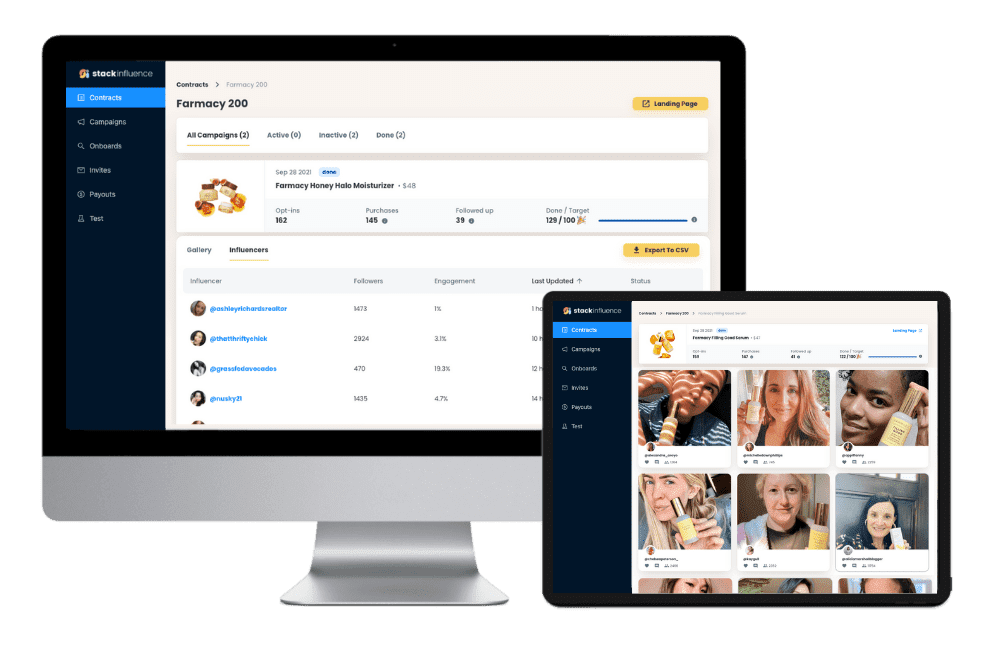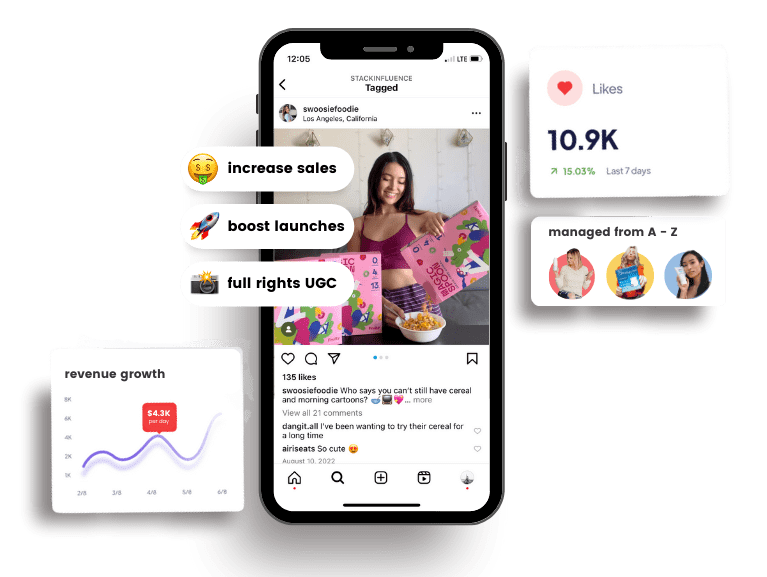What is Instagram Branded Content?
29th
October, 2025
Influencer Marketing
Amazon Marketplace
Artificial Intelligence
TikTok Tips
If you’re scrolling through Instagram and see a post labeled “Paid Partnership with [Brand],” you’ve encountered Instagram branded content. This feature is Instagram’s way of disclosing influencer marketing collaborations – content co-created by a business and a creator (influencer) in exchange for payment or product value. In simple terms, branded content is a social media post (image, video, Story, Reel, etc.) where an influencer or content creator showcases a product or service, and the post is officially tagged to highlight the business partnership.
Why does this matter? Because consumers trust people more than ads. In fact, 63% of 18–34-year-olds trust what an influencer says about a brand far more than what the brand says about itself in ads. We’re constantly discovering new products on Instagram – from the latest fashion trends to gadget recommendations – but we tend to listen to micro-influencers and creators we follow rather than to direct brand promotions. Authentic content from real people resonates as more genuine, which is exactly why Instagram’s branded content tool has become so important for modern marketing.
Why Instagram Branded Content Matters
Instagram boasts over 2 billion monthly active users worldwide as of 2023. It’s a huge playground for brands, including e-commerce businesses and Amazon sellers, to reach potential customers. But with so many ads and posts competing for attention, authenticity is key. That’s where branded content shines. By partnering with influencers – from celebrities to micro-influencers – brands inject a trusted human voice into their marketing.
Remember, people value authenticity: 79% of consumers say that user-generated content (UGC) from real users significantly impacts their purchase decisions, far more than traditional brand content. In the ultra-competitive world of e-commerce, brands (and especially Amazon sellers) are turning to micro-influencers and content creators to gain an edge. These niche creators – often everyday people with dedicated followings – help generate authentic UGC and build consumer trust in ways traditional ads struggle to match. In other words, Instagram branded content allows businesses to leverage that trust and authenticity at scale.
Branded content is a win-win for both parties. Brands get to tap into an influencer’s creativity, audience, and credibility. When an influencer genuinely loves a product and shares it, their followers are more likely to trust the recommendation (if my favorite tech blogger swears by a gadget, I’m inclined to check it out!). This trust rubs off on the brand, lending it credibility by association. Brands also gain a library of influencer-generated visuals and videos – effectively high-quality marketing content they didn’t have to produce in-house. On the other side, creators benefit by monetizing their content and building relationships with brands. A Paid Partnership tag not only discloses the sponsorship (transparency is good for trust and complies with guidelines) but also enhances the creator’s reputation as a professional who partners with brands. Done right, branded content collaborations feel authentic and engaging, rather than like intrusive ads.

Unlock the Power of Micro Influencers and Elevate your Brand Today!

Instagram’s Branded Content Features and Tools

To facilitate these collaborations, Instagram provides a suite of branded content tools (available to business and creator accounts that meet Instagram’s guidelines). Here are the key features that make branded content on Instagram work:
-
- Paid Partnership Tag: The most visible feature – creators can tag a business partner in their post’s header with a “Paid Partnership with [Brand]” label. This immediately signals to viewers that the post is a sponsored collaboration, keeping everything transparent. It also ensures the brand is prominently credited in the content. Only eligible creator and business accounts can use this tag, so brands need to activate it by approving the partnership on their end.
- Shared Insights: When a post is tagged as branded content, both the creator and the brand get access to its performance metrics. Brands can unlock rich, organic insights from the creator’s post – for example, they can see reach, likes, comments, saves, and shares on a feed post, as well as story-specific stats like taps forward/back, replies, and exits. This data sharing is invaluable – it lets the brand measure engagement and ROI of the influencer’s post as if it were one of their own, and both sides can learn what content resonates with the audience.
- Promoting Branded Posts (Ads): Perhaps the biggest advantage – brands can amplify a high-performing influencer post by turning it into an ad. Instagram allows the brand to pay to “Boost” the creator’s branded content post (just like boosting a normal post) or even create a dedicated Branded Content Ad through Facebook Ads Manager to reach a wider targeted audience. Unlike a regular ad made from scratch, a Branded Content Ad uses the creator’s handle and creative, but is backed by the brand’s advertising budget and targeting. This hybrid approach combines the authenticity of influencer content with the reach of paid advertising, often yielding great results (more on that in a moment). Creators simply have to grant permission for the brand to promote their post, which can be done easily in Advanced Settings by toggling “Allow Business Partner to Promote” for that post. Once that’s done, the brand can set up a paid campaign to serve the influencer’s content to a broader audience, complete with all of Meta’s targeting options and analytics.
- Paid Partnership Tag: The most visible feature – creators can tag a business partner in their post’s header with a “Paid Partnership with [Brand]” label. This immediately signals to viewers that the post is a sponsored collaboration, keeping everything transparent. It also ensures the brand is prominently credited in the content. Only eligible creator and business accounts can use this tag, so brands need to activate it by approving the partnership on their end.
In short, Instagram’s branded content tools make it easy to label partnerships clearly, share analytics, and amplify influencer posts beyond the influencer’s own followers. This turns Instagram into a powerful channel for influencer marketing campaigns, blending organic and paid strategies.
How to Set Up Branded Content on Instagram
So, how can brands and influencers actually implement a branded content campaign on Instagram? Here’s a step-by-step guide:
-
- Ensure Eligibility and Compliance: First, both the brand and the influencer need the right account type. Make sure you’re using an Instagram Business or Creator account, and that you comply with Instagram’s Community Guidelines and Branded Content Policies. (Most standard influencers and brands will, but it’s worth double-checking if your content is niche or sensitive.) If you haven’t already, you may need to connect your Instagram account to a Facebook Page and enable Instagram’s branded content tools in your settings. Essentially, Instagram wants to verify that you’re authorized to use the branded content feature.
- Agree on Partnership Terms: Before any posting happens, brand and influencer should get on the same page regarding the collaboration. Typically, the brand will invite the creator to partner (often done via Instagram’s interface or through an influencer platform) and may send over a brief or terms. This includes details like what content is expected, key messaging points or UGC guidelines, posting timelines, and any exclusivity or FTC disclosure requirements. Some brands formalize this with a contract or use tools (like Instagram’s built-in workflow or third-party platforms) to outline the terms. At this stage, you’ll also want to ensure the creator knows how to tag the branded content and that the brand will have the ability to approve the tag. (On Instagram, brands can choose to manually approve tag requests from creators – a setting which can be toggled on for control. Keeping approval on is a good idea so you can control who labels themselves as your partner.)
- Creator Makes the Post (and Tags the Brand): Now comes the fun part – content creation. The influencer creates the Instagram post or Story according to the plan. In the posting process, under Advanced Settings, the creator will see an option to “Tag Business Partner” or mark it as a Paid Partnership. They select the brand’s account, which adds the Paid Partnership with [Brand] label on the content once it’s live. The post then appears on the creator’s feed (or Story) for their followers, just like any other content – but now it’s officially disclosing the collaboration. The brand gets notified of the tag and can see the post insights as it gains traction.
- Boost the Post for Extra Reach (Optional): If the branded post is performing well organically (or you simply want to guarantee it reaches a larger audience beyond the influencer’s followers), the brand can boost the post. This is essentially running the post as an ad directly from the creator’s account. It can be done in-app by the brand (with permission) or via Facebook Ads Manager by selecting the existing post. The brand sets a budget, targeting (such as demographics, interests, lookalike audiences, etc.), and duration for the promotion. This paid boost doesn’t create a new post; it just amplifies the existing one to more people. It’s a great way to get more mileage from a piece of content that’s already proven to resonate. Pro tip: Discuss this with the influencer ahead of time and ensure they’ve allowed business partners to promote their posts – otherwise the boost won’t work.
- Run Branded Content Ads via Ads Manager (Advanced): For even more control, brands can create a dedicated Branded Content Ad in Facebook Ads Manager. This allows you to use influencer content in a new ad unit that appears under the influencer’s handle with the Paid Partnership label. To do this, the brand needs to obtain ad creation access to the creator’s account. This is done by the brand sending a request (in Instagram settings under Business > Branded Content > Request Ad Creation Access) to the creator. The creator accepts the request on their end, granting the brand permission to use their identity in ads. Once that’s set up, the brand can go into Ads Manager and create a campaign as usual (choose objective, audience targeting, budget, etc.), and when selecting the Facebook/Instagram page identity for the ad, choose the creator’s Instagram handle as the “Identity” instead of the brand’s page. Don’t forget to toggle on the “Branded Content” option for the ad. Then, either select an existing post of the creator’s to use as the ad creative or upload a new creative (note: you can’t use certain formats like product catalogs in branded content ads – it has to be a standard image or video). Submit the ad for review, and once it’s approved by Meta and by the creator, it will start running. From the audience’s perspective, it looks like an influencer’s post with a “paid partnership” tag, showing up as a sponsored post in their feed or Stories.
- Monitor Performance and Optimize: After everything is live, keep an eye on the results. Check the insights for the branded content post (reach, engagement, etc.) and the ad analytics in Ads Manager (click-through rates, conversions, etc.). The beauty of branded content is that you get a wealth of data. See which creators or posts are driving the best results – is there a particular influencer whose content is outperforming others? Which audience targeting settings yielded the lowest cost-per-click or highest conversion rate? Use this information to double down on what works. You can also build lookalike audiences based on the people engaging with the branded content, run A/B tests with different creatives, or try new formats (e.g. a Branded Content Reel vs. a photo post) to continually refine your influencer marketing strategy.
- Ensure Eligibility and Compliance: First, both the brand and the influencer need the right account type. Make sure you’re using an Instagram Business or Creator account, and that you comply with Instagram’s Community Guidelines and Branded Content Policies. (Most standard influencers and brands will, but it’s worth double-checking if your content is niche or sensitive.) If you haven’t already, you may need to connect your Instagram account to a Facebook Page and enable Instagram’s branded content tools in your settings. Essentially, Instagram wants to verify that you’re authorized to use the branded content feature.
By following these steps, brands can seamlessly integrate influencer partnerships into their Instagram marketing, ensuring all content is properly disclosed and maximally effective.
The Impact of Branded Content Ads: Performance Data
One of the biggest reasons to use Instagram’s branded content feature is the performance. Marketers have found that ads created from influencer content often significantly outperform regular brand ads. Meta (Instagram’s parent company) ran a study in 2022 comparing campaigns that used a mix of branded content ads and business-as-usual ads versus those that only used standard ads. The results were eye-opening: campaigns with Branded Content Ads saw 53% higher click-through rates (CTR) and a 19% lower cost-per-action (CPA) on average, with a 99% probability that the mixed campaign would outperform running regular ads alone. In another internal analysis of 300 brands, Meta found that Instagram Partnership Ads (another name for branded content ads) had an 82% probability of driving a purchase outcome, a 3.9% lower cost per purchase, and a 2.4× conversion lift compared to similar ads run without the paid partnership label. In plain English, influencer-powered ads drive more clicks and sales for less money.
These numbers aren’t just theory – brands are seeing the difference in practice. For example, activewear brand Vuori tested different Instagram ad strategies: allowlisting (ads via influencer handles but without official partnership tags), regular posts, and branded content ads. The branded content ads were the clear winner, delivering a 25% lower cost per purchase compared to the other methods (and even 20% lower CPA than the ads run from Vuori’s own account). Similarly, travel brand Viator ran a campaign using branded content from multiple travel micro-influencers and achieved a 59.7% lower cost per acquisition for customers. Results like these illustrate how marrying an influencer’s relatable voice with the power of Instagram’s ad platform can dramatically improve marketing efficiency.
Why do branded content ads perform so well? Authenticity and relevance. Content that looks and feels like a real user’s post (because it is!) tends to stop the scroll more than obvious ads. People are more likely to trust and click on a skincare tip from their favorite beauty creator than a polished ad from the brand itself. As a result, user-generated content used in ads often outperforms traditional advertising creatives – studies show UGC-based ads get significantly higher CTRs and lower costs than typical brand ads. By leveraging the influencer’s creative and voice, branded content ads come across as native content in the feed, which leads to better engagement and conversion. The data backs it up, and brands are taking notice.
Tips for Successful Instagram Branded Content Campaigns

Ready to dive into branded content? To maximize your success, keep these best practices in mind when planning an Instagram branded content campaign:
-
- Partner with the Right Mix of Creators: Don’t just go for the biggest influencer you can find – micro-influencers often have highly engaged audiences, while larger creators offer broad reach. A balanced mix can give you the best of both worlds. In fact, research shows there’s no significant drop in performance for conversion-focused campaigns when using smaller creators versus million-plus-followers influencers. By collaborating with a range of creators (niche micro-influencers and big names alike), you can tap into diverse audiences. This not only increases your reach, but also ensures you’re hitting various customer segments with content that feels tailored to them. Tip: When scouting influencers, prioritize authentic alignment with your product – a creator whose niche or personal brand fits your product will create content that feels more genuine and will resonate better with followers.
- Double Down on Top Performers: Once your campaign is running, pay attention to which influencers’ content is delivering the best results. It might turn out that one micro-influencer’s post is driving an exceptional click-through rate or that a particular creator’s audience is converting to sales at a high rate. Focus your efforts where the ROI is highest. For example, you can allocate more budget to boosting the top-performing posts, or expand your partnership with that creator (have them create more content, or extend the campaign). The beauty of Instagram’s shared insights is that you can clearly see who is pulling their weight. Don’t be afraid to scale up what works – it can dramatically improve your overall campaign performance.
- Show the Product Early: When it comes to video content (Reels, Stories, or longer videos), encourage creators to feature your product within the first few seconds. Why? Because branded content ads that show the brand or product in the first 3 seconds drive 44% more brand interest on average. In a fast-scrolling social feed, first impressions are everything. You want viewers to immediately catch what the product is and why it’s awesome. That doesn’t mean the content should feel like a blatant commercial – but a quick cameo of the product or a mention of the brand upfront can hook viewers and make the difference between them stopping to watch vs. swiping past. It also reinforces brand recall, even if the viewer doesn’t watch the entire ad.
- Give Creators Creative Control: While it’s important to communicate your goals and any must-have information, remember that influencers know their audience best. The whole appeal of influencer content is that it feels genuine and native to their feed. If a brand hands a strict script or a laundry list of do’s and don’ts, the content can come off as forced, which defeats the purpose. Instead, provide guidelines and let the creator present your product in their own voice and style. Trust them to highlight the product in a way that will resonate. The more freedom you give within reasonable guardrails, the more authentic (and effective) the content will be. This also builds a better working relationship – creators will enjoy working with brands that respect their creative process, which can lead to better content quality and long-term partnerships.
- Design for Sound-Off Viewing: Many Instagram users scroll with their sound off, especially when watching videos in public or at work. If your branded content ad relies entirely on a voiceover or dialogue to convey the message, you risk losing a huge chunk of viewers. Meta’s research found that ads optimized for sound-off (think captions, on-screen text, or visuals that tell the story without audio) drive 38% more brand interest. Make sure your influencer partners are aware of this. For example, if a creator is doing a talking video about your product, ensure they use Instagram’s caption sticker or add subtitles so that someone can get the gist without audio. Alternatively, use clear visuals and text overlays to communicate key points. By planning for silent viewing, you’ll increase engagement and not miss out on interested viewers who just haven’t tapped the sound on.
- Partner with the Right Mix of Creators: Don’t just go for the biggest influencer you can find – micro-influencers often have highly engaged audiences, while larger creators offer broad reach. A balanced mix can give you the best of both worlds. In fact, research shows there’s no significant drop in performance for conversion-focused campaigns when using smaller creators versus million-plus-followers influencers. By collaborating with a range of creators (niche micro-influencers and big names alike), you can tap into diverse audiences. This not only increases your reach, but also ensures you’re hitting various customer segments with content that feels tailored to them. Tip: When scouting influencers, prioritize authentic alignment with your product – a creator whose niche or personal brand fits your product will create content that feels more genuine and will resonate better with followers.
By following these tips – choosing the right influencers, amplifying what works, and creating content that’s authentic and optimized for the platform – you’ll set your Instagram branded content campaigns up for success.

Unlock the Power of Micro Influencers and Elevate your Brand Today!

Conclusion to What is Instagram Branded Content?
In a digital landscape crowded with ads, Instagram branded content offers a refreshing way to connect with consumers through authenticity and trust. When brands partner with influencers and creators to tell their story, the message comes from a relatable voice, making it more likely to resonate with the audience. Whether you’re a global brand or an Amazon seller building your e-commerce presence, leveraging branded content can be a game-changer for building brand awareness, engagement, and sales.
Keep in mind that success with branded content is an ongoing journey – it involves testing different creators and content styles, learning from the data, and refining your approach. But the payoff is worth it: a community of customers who discovered you through someone they already trust and who see your brand as authentic and credible.

By William Gasner
CMO at Stack Influence
William Gasner is the CMO of Stack Influence, he's a 6X founder, a 7-Figure eCommerce seller, and has been featured in leading publications like Forbes, Business Insider, and Wired for his thoughts on the influencer marketing and eCommerce industries.
Want new articles before they get published? Subscribe to our Awesome Newsletter.
stack up your influence
turning creativity into currency
our headquarters
111 NE 1st St, Miami, FL 33132
our contact info
[email protected]
stack up your influence
turning creativity into currency
our headquarters
111 NE 1st St, 8th Floor
Miami, FL 33132


